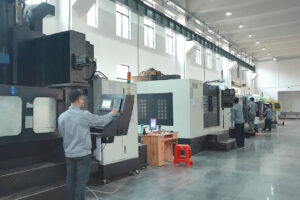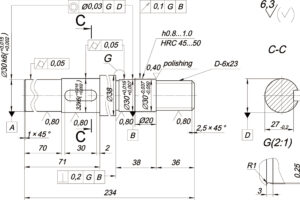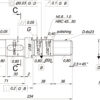The sheet metal stamping process transforms by stamping hot or cold-rolled steel sheets to create the shape required for your part. This technique allows many parts to be produced simultaneously, but it can also result in about 15% of the raw material being scrap. When working with sheet metal stamping, three types of dies are used – cutting, punching, and bending.
- Trimming involves cutting a part out of sheet metal. This is done by striking a metal sheet with a die that cuts the sheet into the desired shape. Punched parts will have burrs on the edges, so they must be filed or machined before use.
- Punching is the process of punching a hole in a sheet of metal by placing it between two dies and forcing them together.
- Bending is the deformation of metal by using the pressure of a die, and this type of stamping is often used to make parts with curves.
Common problems of sheet metal stamping parts:
1. Burrs: In punching or cutting corners, the residual material is not entirely left, and burrs are generated in the lower part of the truncated surface of the steel plate. Based on the truncated surface, when the burr height is more than 0.2mm, the iron powder will damage the mold and cause convex and concave.
2. Concave and convex: The material’s surface is abnormally convex or concave, which is caused by mixing foreign objects (iron filings, dust) in the uncoiled wire.
3. Roller printing: It is caused by foreign matter attached to the cleaning roller or feeding roller (occurs at a fixed pitch). Generally, the foreign matter can be removed from the roller printing on the sheet.
4. Sliding mark: It occurs when the roller suddenly stops or accelerates due to the sliding of the roller.
5. Coil crushing and edge wrinkling: The wrinkling situation caused by the small gap between the guide rollers of the uncoiling line or the guide rollers on the mold is caused by the unbalanced feeding of the coil material.
6. Scratches: The main reason for scratches on parts is sharp scratches on the mold or metal dust falling into the mold. The preventive measures include grinding the mold’s scratches and removing the metal dust.
7. Bottom cracking: The main reason for the bottom cracking of the part is the poor plasticity of the material or the over-tightening of the blank mold holder. The preventive measures are to replace the material with better plasticity or loosen the blank holder.
8. Wrinkles on the side walls: The main reasons for the wrinkles on the side walls of the parts are the insufficient thickness of the material or the deviation of the upper and lower molds during installation, resulting in a large gap on one side and a small gap on the other side. The way to prevent such problems is to replace them with time material and readjust the mold.
Advantages of sheet metal stamping parts:
- Low cost
Sheet metal stamping is a low-cost manufacturing technique. Its cost is generally lower than other methods, making it ideal for small businesses on a budget. Since this method does not require molds or tools to create the part or part, it is also considered by many to be less costly. However, the toolless aspect of sheet metal stamping can sometimes make it more expensive because you pay someone for the layout and design work instead of using standardized tools.
- Mass production
Sheet metal stamping can produce thousands of identical parts at a time, so this type of manufacturing allows you to manufacture large numbers of products while maintaining quality standards efficiently. This benefit mainly applies to parts that are simple in shape and do not require extensive customization.
- Easy to use
Shears, punches, and bending dies make up most of the tools for sheet metal stamping, so this fabrication is relatively easy to learn.
- Multifunctional
Sheet metal stamping is a versatile manufacturing technique that creates parts of various shapes and sizes. This makes it a good choice for businesses that require high-volume production. Additionally, this type of stamping can create both simple and complex parts.
Disadvantages of sheet metal stamping parts:
- Scrap rate
Sheet metal stamping has an inherently high scrap rate. Stamping dies require a flat, smooth sheet metal surface to work correctly. If the sheet is uneven, the effect will be poor, and the metal must be scrapped. Because this manufacturing process requires large areas of sheet metal, you risk wasting many small pieces that don’t meet quality standards. Mass production will increase your scrap count.
- Not easy to customize
Simple, requiring few custom machine parts, it works best with sheet metal stamping techniques. Simple shapes and curves make manufacturing easy and cheap. However, you may have to pay more when using this technique on custom projects or highly detailed parts due to design fees and additional labor costs required to complete the project.
- Limited design and size options
Sheet metal stamping is the best option for making simple parts, but if you need a more complex or detailed part, this may not be the best option for manufacturing. The stampings used in sheet metal stamping cannot easily create tight curves or intricate details, so if your part has a complex design, you may have to look for other methods.
All that said, sheet metal stamping is a good choice if you need many parts quickly and cheaply.







